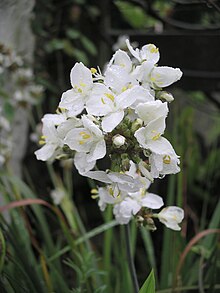Libertia
| Libertia | |
|---|---|
 |
|
| Libertia grandiflora | |
| Scientific classification | |
| Kingdom: | Plantae |
| (unranked): | Angiosperms |
| (unranked): | Monocots |
| Order: | Asparagales |
| Family: | Iridaceae |
| Subfamily: | Iridoideae |
| Tribe: | Sisyrinchieae |
| Genus: |
Libertia Spreng. 1824, conserved name not Dumort. 1822 (syn of Hosta) nor Lej. 1825 (syn of Bromus) |
| Type species | |
|
Libertia ixioides (Forster f.) Spreng. |
|
| Synonyms | |
|
|
Libertia is a genus of monocotyledenous plants in the family Iridaceae, first described as a genus in 1824. It is native to South America, Australia, New Guinea, and New Zealand. Several of species are endemic to New Zealand.
They are all perennials growing from short woody rhizomes, with simple, linear or narrowly lanceolate basal leaves which are often green but may be red or yellow depending on the species. The showy white trimerous flowers are open in spring and are followed by capsules opening by three valves which contain the numerous black seeds.
The genus was named after the Belgian botanist Marie-Anne Libert (1782–1865) (also referred to as Anne-Marie Libert).
Numerous names have been coined using the name Libertia, referring to species that are now regarded as better suited to other genera (Bromus Cardiocrinum Hosta Orthrosanthus). We provide links to help you find appropriate information.
...
Wikipedia
